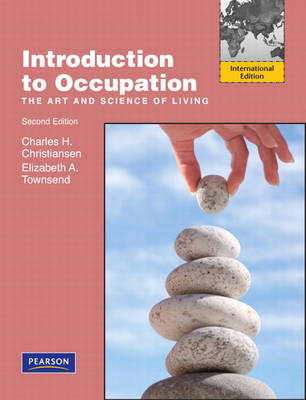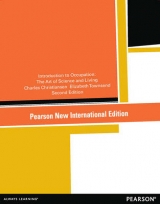
Introduction to Occupation
Pearson (Verlag)
978-0-13-237684-6 (ISBN)
- Titel erscheint in neuer Auflage
- Artikel merken
Chapter 1 An Introduction to Occupation by Charles Christiansen & Elizabeth Townsend
Chapter Profile
Introduction
Understanding the Complexity of Occupation
How Do You Occupy Your Time?
What Occupies You?
Occupations Create Meaning
What Is Your Occupation?
How Does Context Determine What People Do (And When)?
Biological Factors
Psychological Factors
Contextual Factors
Occupations, Health, Well-Being and Participation in Society
Chapter Summary
References
Chapter 2 Cultural Perspectives on Occupations by Michael Iwama
Chapter Profile
Introduction
Relativism and the Consequences of Culture
Culture in Time and Place
Culture as Shared Experience and Meanings
Science as Culture and Context for Occupational Knowledge
Situated Constructions of Occupation: A Cultural Example
Particular World Views: East Asian Views of the Cosmos
An Examination of the East Asian Version of the Cosmological Myth
Vertifical and Horizontal Social Indexing
Vertical Social Indexing
Horizontal Social Indexing
Inter-dependence and “Amae”
References
Chapter 3 The Study of Occupation by Helene Polatajko
Chapter Profile
Introduction
Ways of Knowing
Understanding the Who, What, When, Where, How and Why of Occupation
Disciplinary Ways of Knowing
Paradigms for Inquiry
Paradigms for the Study of Occupation
Methods of Inquiry for the Study of Occupation
The Question
Design and Data Collection Methods
Understanding Who
Understanding What
Understanding When
Understanding Where
Understanding How
Understanding Why
Chapter Summary
References
Endnotes
Chapter 4 What Is Occupation? Interdisciplinary Perspectives on Defining and Classifying Human Activity by Jennifer Jarman
Chapter Profile
Introduction
Occupation in Occupational Therapy and Occupational Science
Occupation in the Social Sciences
Occupation in Government Statistics
Chapter Summary
References
Endnotes
Chapter 5 What Do People Do? By Andrew Harvey & Wendy Pentland
Chapter Profile
Introduction
The Structure of Daily Occupations
Conceptualizing What People Do
Four Types of Occupations: Necessary, Contracted, Committed, Free Time
Occupational Roles
Life Projects
Meaning of Activities and Occupations
Factors Influencing What People Do: Intrinsic, Extrinsic
Dimensions of Occupational Behavior
Contextual Constraints Influencing Occupational Behavour
Why Study What People Do?
How Do We Find Out What People Do?
What Do People Do?
Time Use Across Countries Over Time
Time Use Across Sub-populations
The Context of Doing
Secondary Activity and Occupation
Chapter Summary
References
Chapter 6 Occupational Development by Jane Davis & Helene Polatajko
Chapter Profile
Introduction
An Occupational Perspective on Development
An Occupational Perspective
A Perspective on Development
Interactionism as a Framework for Occupational Development
An Interactionist Definition of Occupational Development
An Interactional Model of Occupational Development
Chapter Summary
References
Endnotes
Chapter 7 The Occupational Nature of Social Groups by Charles Christiansen & Elizabeth Townsend
Chapter Profile
Introduction
What Makes Communities Inherently Social and Occupational? Experiencing Shared Occupations
How and Why Did Group Living Develop? Evolutionary Highlights in Developing the Occupational Nature of Social Groups
How and Why Do Occupations Determine a Social Group’s Potential to Flounder or Flourish?
Chapter Summary
References
Chapter 8 Occupational Transitions: Work to Retirement by Hans Jonsson
Chapter Profile
Introduction
Retirement as an Occupational Transition
Attitudes to Retirement
Leaving Work for Retirement — Why are you Leaving?
Different Directions in Retirement Narratives
Going into Retirement — Why are you Entering?
The Paradox of Freedom
Gliding Into a Slower Rhythm of Life
Change in Meaning
Two Types of Retirement Narratives — To Get Time or To Kill Time
Engaging Occupation For a Good Life as Retiree
Cultural Images of Retirement
References
Chapter 9 Occupational Balance and Well-Being by Catherine Backman
Chapter Profile
Introduction
Occupational Balance
Origins in Occupational Therapy
Occupational Imbalance
Work — Life Balance
Work — Life Conflict and Role Overload
Lifestyle Balance
Is Occupational Balance Achievable?
Occupational Balance, Health and Well-Being
Chapter Summary
References
Chapter 10 Occupations and Places by Tobi Ballou Hamilton
Chapter Profile
Introduction
Understanding Place
Occupations as Experiences in Places
How Places Influence Occupation
Places as Environments for Learning, Play and Safety
How Occupations Influence Places
Place, Occupations, and Well-Being
Chapter Summary
References
Chapter 11 Work, Occupation and Leisure by Jiri Zuzanek
Chapter Profile
Introduction
Empirical Support for the Work-Leisure Relationship Scenarios
Leisure and Occupation
Long Hours of Work, Time Crunch, and Leisure
Chapter Summary
References
Chapter 12 Occupational Deprivation: Understanding Limited Participation by Gail Whiteford
Chapter Profile
Introduction
Defining Occupational Deprivation
Identifying Barriers to Participation: Five Illustrations of Occupational Deprivation
Geographic Isolation
Problem Conditions of Employment
Incarceration
Sex-Role Stereotyping
Refugee-ism
Disability and Occupational Deprivation
Using an Occupational Justice Framework to Address Occupational Deprivation
Chapter Summary
References
Suggested Readings
Chapter 13 Occupational Justice by Robin Stadnyk, Elizabeth Townsend & Ann Wilcock
Chapter Profile
Introduction
Defining Occupational Justice
Ideas About Justice
An Evolving Theory of Occupational Justice
Distinctions Between Occupational and Social Justice
Using Stories to Consider an Exploratory Theory of Occupational Justice
Chapter Summary
References
Endnotes
Chapter 14 Occupational Science and Occupational Therapy: Occupation at Centre Stage by Matthew Molineux
Chapter Profile
Occupational Therapy
A Brief Historical Overview
Occupation in Practice
Occupational Science
What is Occupational Science?
Occupational Science Research
The Relationship Between the Science and Therapy
Conclusion
References
Chapter 15 Globalization and Occupation: Perspectives from Japan, South Africa, and Japan by Eric Asaba, Alfred Ramukumba, Annah Lesunyani, & Simon Kam Man Wong
Chapter Profile
Introduction
An Occupational Perspective from Japan
Introduction
Observations from Japanese Psychiatry
Activity, Time Use, and Technological Trends
Reflections on Past, Present, and Future
Conclusion
An Occupational Perspective from South Africa
Diverse Cultural Contexts
Occupational Choices
Common Occupations Among South Africans
Occupations Creating Communities
Community Development Occupations
Current and Future Possible Occupations in the South African Context
An Occupational Perspective from Hong Kong, China
Introduction
Typical Occupations in Hong Kong
Technology and Occupation
Globalization and Occupation
Political, Socioeconomic Environment and Occupation
Conclusion
Chapter Summary
Glossary
Answers to Study Guide Questions
Index
| Erscheint lt. Verlag | 21.9.2010 |
|---|---|
| Sprache | englisch |
| Maße | 177 x 229 mm |
| Gewicht | 710 g |
| Themenwelt | Medizin / Pharmazie ► Medizinische Fachgebiete ► Arbeits- / Sozial- / Umweltmedizin |
| Medizin / Pharmazie ► Pflege | |
| ISBN-10 | 0-13-237684-9 / 0132376849 |
| ISBN-13 | 978-0-13-237684-6 / 9780132376846 |
| Zustand | Neuware |
| Informationen gemäß Produktsicherheitsverordnung (GPSR) | |
| Haben Sie eine Frage zum Produkt? |
aus dem Bereich



